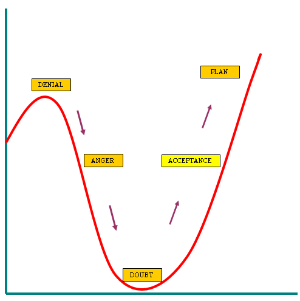Leadership - Problems of change
Problems of change
General
We have seen that change runs through a range of emotions.
This usually begins with denial of what is or might be happening.
This quickly turns to anger at the situation with blame apportioned on someone (or yourself for not noticing what was happening).
This then turns to doubt and acceptance of the situation.
Finally, you realise that you have to get on with the situation and start to formulate plans (see the diagram above).
We have seen that the severity of the curve will depend upon the individual and the type of change.
Change can be seen as ‘revolutionary’ (completely different to what has gone before) or evolutionary (building on what has gone before).
The curve represents a final realisation of what is important and not what is urgent [see Prioritise - Basics].
It gives some indication of the ‘effort’ people are prepared to expend over the change period it is not related directly to a time factor.
In general, people fall into approximate groups that reflect how they view the proposed change.
A small percentage, 2 or 3%, could be termed ‘dreamers’. They don’t live in the real world and will not be seen as leaders.
The next group, about 10%, like the idea and will be keen to persuade others to follow early in the process. People tend to listen to this group.
The majority of people, about 60%, can go either way depending on the influences they receive. They are open to persuasion but would be quite happy to remain where they are.
About 20% are hard to convince but usually go along once the majority are in favour.
The last few, about 8%, resist change completely.
The process
The emotion curve above reflects the gradual acceptance of an individual as they come to terms with the change.
Over the implementation of the change there are many hurdles to consider.
Initially, there will be speculation and rumour as to the purpose and outcome of the change.
A lack of clarity tends to fuel these comments.
Once information is made available doubts start to surface.
As the new idea begins to take hold so do prejudices and problems and hurdles start to appear.
The initial 2 or 3% see the benefits of the proposals early on and actively promote it.
Once the ball starts to roll the organisation becomes less defensive in their approach and discussion becomes more open.
From an organisational viewpoint it is good to achieve some big successes during the initial stages of the implementation.
However, you must accept that there will also be a few failures along the way.
As the implementation gains momentum more successes will be seen which will further accelerate change.
During the whole process the organisation must repeatedly communicate the vision for the change.
Familiarity will gradually encourage acceptance.
Once people see the success during one exercise of change they will be more willing to embrace other changes.
The atmosphere
In the main, people do not resist change per se but resist being changed.
It is the leader’s responsibility to create the correct environment so that change can happen as smoothly as possible.
Any leader will require a good relationship with his or her personnel. They need to know that they are liked and respected and in turn they will give respect to the leader and trust him or her.
The leader must establish good relations with the people.
Naturally, if past change has resulted in positive benefits future change will be easier.
Before a leader can change others, he or she must show that they are prepared to change as well.
If you know that there are key influencers within a group convince them of the merits of your vision for change and put them into positions where their influence can have the biggest benefits.
If you have a number of key influencers that are against the change meet with them individually to try to persuade them.
If you have more influencers on your side get them all together to discuss the change.
For any meeting that you organise make sure that you have an appropriate agenda.
Try to focus on the key issues and get the meeting off to a good start by raising some very positive aspects of the change.
If any information ‘gets out’ before a meeting make sure that it is positive.
Remember, the change is for the people and not for the leader.
Constantly reinforce the benefits that will result from the change.
People change if they feel they are involved in the decision making, creating a feeling of ownership.
Communication is critical.
Inform people of the change and its objectives and the reasoning behind it an the timing.
Refer to the positives and the negatives.
If job losses are likely to occur then provide appropriate support.
Encourage feedback and create opportunities for discussion and get people involved in the discussions that will be affected.
Don’t be too rigid. Admit errors and modify areas as necessary.
Keep up your own enthusiasm and drive for the change and recognise others that help make the change possible.
Inevitable
Change will definitely occur. Hopefully, managed change is better than just allowing things to drift over time.
Change can be positive or negative and is usually the latter if areas above are not considered.
Change usually means growth.



